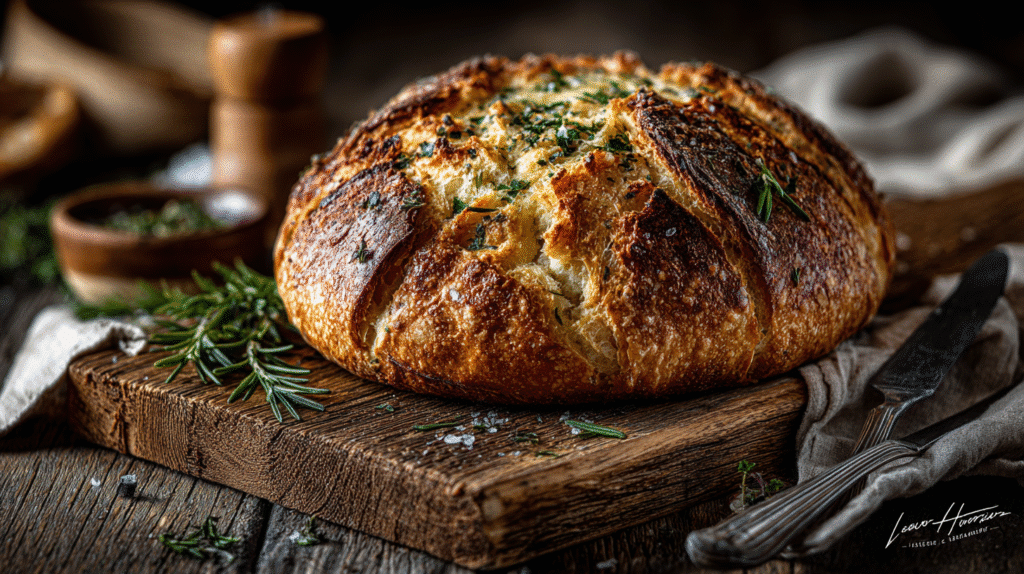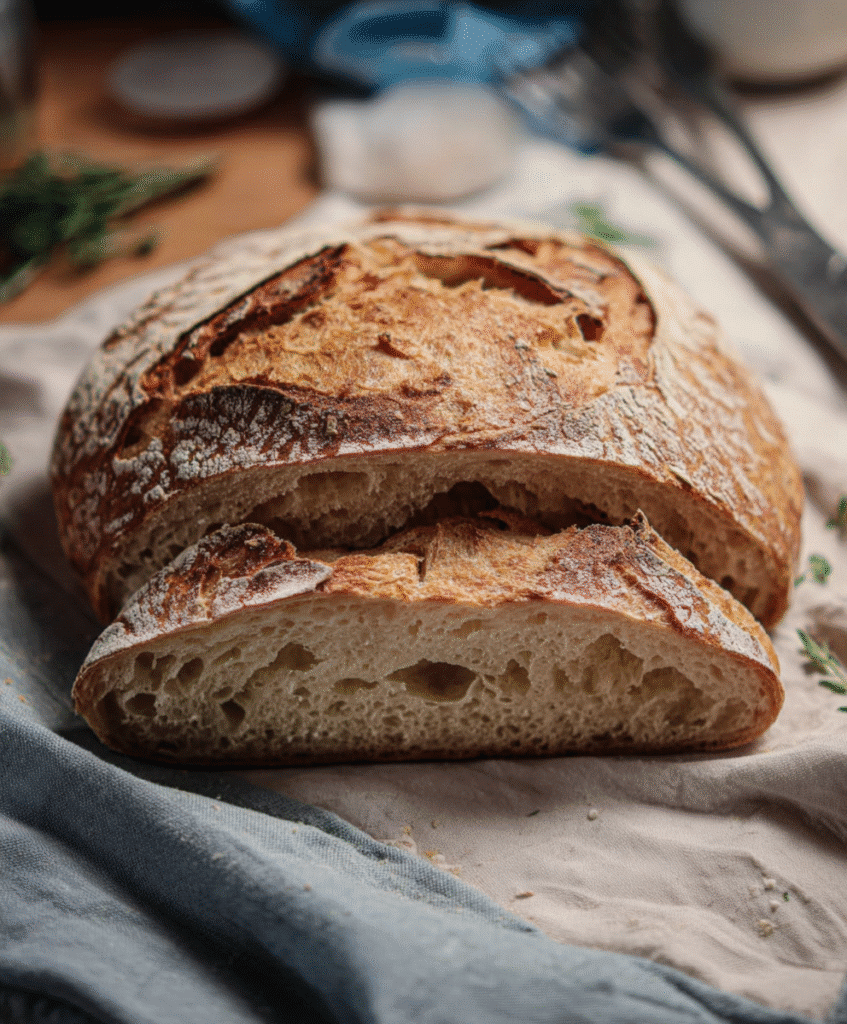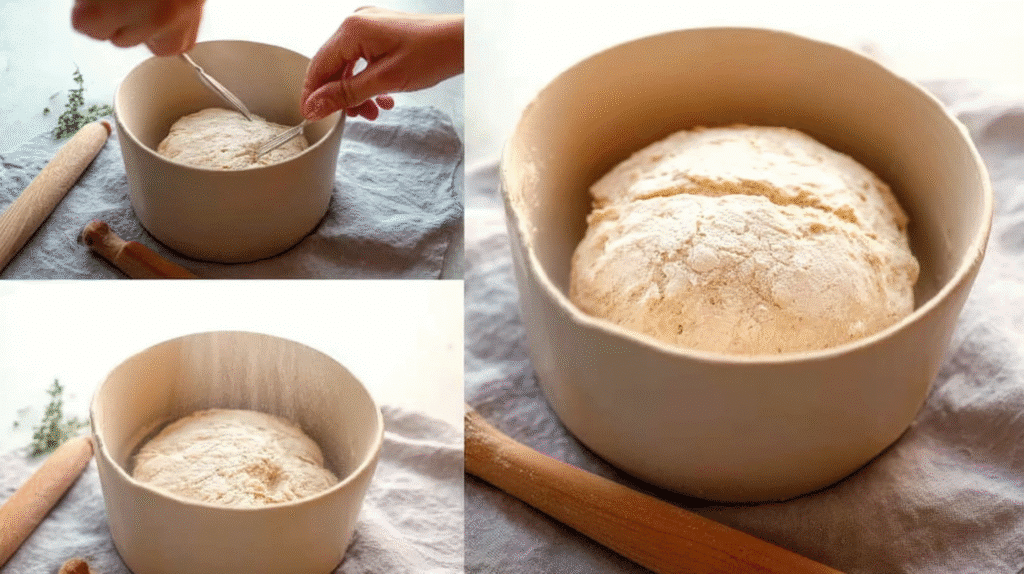
The aroma of warm, crusty bread baking in the kitchen evokes a profound sense of nostalgia.
It takes me back to weekends with my grandmother, who made her bread from scratch—never with shortcuts, always with soul. Back then, we didn’t talk about sourdough starters or hydration percentages. She had a feel for the dough and the time it needed to come alive.
Jump to the present—where life is more hectic and chaotic—the thought of keeping up with a sourdough starter feels daunting for many. That’s what makes this no-starter sourdough recipe a true breakthrough. It brings back that same depth of flavor and chewy texture without the fuss, the feeding, or the discard.
This approach captures the spirit of traditional sourdough while fitting into a modern rhythm. And just like Recent Recipe’s mission of reviving beloved dishes with modern twists, this recipe honors the past while embracing convenience. Whether you’re brand new to bread baking or just not into the starter jar life, this no starter sourdough recipe will make your kitchen smell amazing—and your table feel even warmer.
Let’s dive into the reasons why skipping the starter might just be the smartest move you’ve made all week.
Why You Should Try a No Starter Sourdough Recipe
Breaking the Sourdough Myth: Starters Aren’t the Only Way
If you’ve ever wanted to make sourdough but felt intimidated by starter maintenance, you’re not alone. Traditional sourdough starters require consistent feeding, discarding, and babysitting—a process that can feel like a second pet. This turns many would-be bakers away before they even start.
Here’s the good news: you don’t need a starter to make a sourdough-style bread that tastes amazing. A no starter sourdough recipe uses naturally fermented ingredients or extended fermentation times to recreate that classic tang and texture, without ever mixing flour and water in a jar for days.
Instead, ingredients like plain yogurt, apple cider vinegar, lemon juice, or even wild fermentation with time and warmth can mimic the effects of a mature starter. You get the complex flavor and chewy crumb of sourdough—without the stress.
This method also aligns beautifully with the growing interest in no discard sourdough starter recipes, where waste is minimized and flavor is prioritized.
Practical Reasons to Skip the Starter
Skipping the starter isn’t just about convenience—it can actually produce great results. Here’s why people love the no starter sourdough bread recipe approach:
- Saves time: You can go from mix to bake in less than 24 hours without needing a week of prep.
- Less waste: Traditional starters require regular discard. A no starter sourdough recipe means you skip that step entirely.
- Easier on beginners: If you’ve never baked bread, this is a gentle entry point.
- Still gut-friendly: The long fermentation used here helps break down gluten and phytic acid, just like with traditional sourdough.
For busy families, home cooks, or anyone experimenting in the kitchen, this method is not just forgiving—it’s empowering. And if you’re already looking for ideas to add to your breakfast or lunch plans, this loaf fits beautifully into either meal.

Smart Substitutes & Fermentation Secrets for Sourdough Flavor
What Can I Use Instead of a Sourdough Starter?
Believe it or not, you already have ingredients in your kitchen that can replicate the effects of a sourdough starter—no feeding or discard required. The secret is in leveraging mild acidity and slow fermentation. While traditional starters are made of wild yeast and bacteria developed over time, these quick substitutes mimic their behavior well enough to produce a tangy, chewy, deeply satisfying loaf.
Here are some go-to alternatives to sourdough starter:
- Plain unsweetened yogurt: Contains live cultures that introduce acidity and slight fermentation.
- Lemon juice or apple cider vinegar: Both bring a quick acidic boost to help simulate that classic sour tang.
- Buttermilk or kefir: Also contain lactic acid bacteria and make excellent additions for a soft crumb.
- Commercial yeast + long proofing: Extend the rise time (12–18 hours) at room temperature and watch flavor develop naturally—without a formal starter.
Using these ingredients doesn’t make your bread any less “authentic.” In fact, many older European baking methods included spontaneous fermentation before the modern starter became a thing.
If you’re into easy sourdough starter recipe no discard styles, this approach fits perfectly. You’re building flavor efficiently and minimizing waste, one delicious loaf at a time.
PrintNo Starter Sourdough Recipe That Works Every Time
- Total Time: 20 hours
- Yield: 1 loaf 1x
Description
This no starter sourdough recipe delivers that signature tang and chewy texture—without the need for a sourdough starter or discard routine.
Ingredients
3 cups (360g) all-purpose or bread flour
1½ cups (360ml) lukewarm water
1½ tsp salt
¼ tsp instant yeast
1 tsp apple cider vinegar or lemon juice
1 tbsp plain yogurt (optional)
Instructions
1. In a large bowl, mix flour, salt, and yeast. Add water, vinegar, and yogurt. Mix until a sticky dough forms.
2. Cover and let rise at room temperature for 12–18 hours until bubbly and doubled in size.
3. Turn dough onto a floured surface. Shape into a ball, folding the edges inward.
4. Place dough on parchment paper, cover, and let rise for 1–2 hours.
5. Preheat oven to 450°F with a Dutch oven inside.
6. Score the dough, place it in the hot Dutch oven. Cover and bake 30 minutes.
7. Remove lid and bake 15–20 minutes more until golden and crusty.
8. Cool on wire rack before slicing.
Notes
For stronger sour flavor, ferment longer or cold-proof in the fridge overnight.
Use bread flour for extra chewiness.
A Dutch oven traps steam and gives the best crust.
- Prep Time: 15 minutes
- Cook Time: 45 minutes
- Category: bread
- Method: baking
- Cuisine: American
Nutrition
- Serving Size: 1 slice
- Calories: 160
- Sugar: 0g
- Sodium: 300mg
- Fat: 0.5g
- Saturated Fat: 0g
- Unsaturated Fat: 0.5g
- Trans Fat: 0g
- Carbohydrates: 33g
- Fiber: 1g
- Protein: 4g
- Cholesterol: 0mg
Keywords: no starter sourdough recipe, sourdough bread recipe no starter, no discard sourdough starter recipes, easy sourdough starter recipe no discard
How to Mimic Sourdough Flavor Without a Starter
The magic of sourdough isn’t just in the starter—it’s in the process. Long fermentation time and room temperature play a huge role in flavor development. When dough ferments slowly, it breaks down sugars and proteins, resulting in complex flavor and improved digestibility.
Here’s how to make the most of it:
- Use cold proofing: After a bulk rise at room temperature, refrigerate the dough for 12–24 hours. Cold fermentation enhances the tang and texture.
- Add a splash of vinegar or lemon juice: Just 1–2 teaspoons in the dough boosts acidity and mimics the lactic acid tang of real sourdough.
- Let time do the work: Instead of rushing the process, extend bulk fermentation to 10–16 hours. The result is a well-developed dough that feels alive—just like traditional sourdough.
If you’re curious about results that rival a proper sourdough bread recipe no starter, you’ll be surprised how effective this method is. Many bakers find that once they get the hang of these substitutions, they rarely miss maintaining a starter at all.
This fermentation method is also a great fit for weekend baking routines. Mix your dough Friday night, let it ferment slowly, and bake a beautifully golden loaf Saturday or Sunday morning. Pair it with your favorite jam, soup, or spread and you’ve got a new dinner favorite in the making.

The Best No Starter Sourdough Recipe: Simple, Tangy, Reliable
Ingredients & Pantry Prep
This recipe uses just a handful of kitchen staples—no exotic ingredients, no sourdough starter, and absolutely no discard. You’ll rely on slow fermentation and a few clever tweaks to get the depth of flavor that usually takes weeks to develop.
This base recipe is flexible and forgiving—perfect for beginners or anyone interested in no discard sourdough starter recipes that don’t require constant upkeep.
Instructions: Step-by-Step
- Mix the dough
In a large bowl, combine the flour, salt, and yeast. Add the water, vinegar, and yogurt (if using), and mix until a sticky dough forms. - First rise (bulk fermentation)
Cover with a damp towel and let rest at room temperature for 12–18 hours. The dough should rise until it doubles in size and appears airy and bubbly. - Shape the dough
Turn it out onto a floured surface. Gently shape into a ball, folding the edges inward to build tension. - Second rise (proofing)
Place dough seam-side down on parchment. Let rise for 1–2 hours while the oven preheats to 450°F (232°C). Place a Dutch oven inside to heat up. - Score and bake
Use a sharp knife to score the top. Place the dough into the preheated Dutch oven, cover it, and bake for 30 minutes.Uncover and continue baking for another 15–20 minutes, until the crust turns golden brown. - Cool completely
Let the bread cool on a wire rack before slicing. This step locks in moisture and flavor.
The result? A gorgeously golden, crusty loaf that’s chewy, airy, and full of depth—just like sourdough. It’s ideal for rustic toast at breakfast, a hearty sandwich at lunch, or as a side with soup at dinner.
This method proves that a no starter sourdough bread recipe can be just as satisfying as its more complicated cousin—and way more accessible.
Table of contents
Table of Contents
Does No Starter Sourdough Still Taste Sour?
Yes—when made with the right technique. The key to sour flavor is fermentation, not the starter itself. In this no starter sourdough recipe, using a bit of lemon juice or vinegar and allowing the dough to ferment for 12–18 hours helps develop that trademark tang. If you cold-proof the dough in the fridge overnight, the flavor intensifies even more. It’s surprisingly close to traditional sourdough—and without the week-long wait.
Can I Make Sourdough Bread Without a Starter?
Absolutely. This recipe is proof that you can. By using small amounts of yeast and a long fermentation period, you let the dough develop its own mild sourness. There’s no need to maintain a starter when time and temperature can build complexity for you. If you’re tired of feeding a jar of dough daily, this method is a breath of fresh air.
Many beginner bakers who try this style never go back to traditional methods. It’s also a top choice for those who enjoy easy sourdough starter recipe no discard types—quick, clean, and flavorful.
What Can I Use Instead of a Sourdough Starter?
Here’s a recap of the most effective starter substitutes:
Apple cider vinegar: Adds acidity and aroma.
Plain yogurt: Introduces live cultures and softness.
Buttermilk or kefir: Great for tender crumb and tang.
Long fermentation with commercial yeast: Builds natural sour flavor with time.
These ingredients allow flexibility based on what you have on hand. Whether you’re prepping a dessert to go with it or a sandwich base for weekday meals, this method adapts to your needs.
How Long Should I Ferment Dough to Get a Sourdough-Like Flavor?
Aim for 12 to 18 hours at room temperature for maximum flavor. For even better results, refrigerate the dough overnight for an extended cold fermentation. This replicates the bacterial development found in traditional sourdough and deepens the flavor without any extra steps.
The longer the fermentation (without over-proofing), the closer you’ll get to that classic sour profile. Just be sure your kitchen is cool enough to prevent over-fermenting. If you’re using warm climates, shorten the timing or do a partial cold ferment.
Is a No Starter Sourdough Recipe Healthier Than Regular Bread?
Yes—in several ways. Although it doesn’t contain a traditional sourdough starter, the long fermentation still breaks down phytic acid and helps your body absorb more nutrients. It’s also easier on digestion compared to regular white bread. Plus:
Fewer additives: You control every ingredient.
Better blood sugar response: Slow fermentation helps lower the glycemic index.
Less gluten stress: Fermentation helps pre-digest the gluten, making it more tolerable for some individuals.
Pair it with healthy fats like avocado or fermented spreads, and it turns into a nutrient-dense, gut-friendly option for everyday meals.







